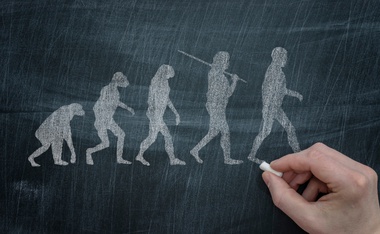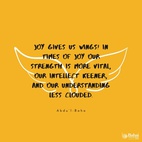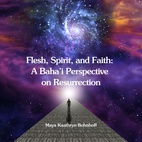The views expressed in our content reflect individual perspectives and do not represent the authoritative views of the Baha'i Faith.
From a big picture perspective, all of reality – everything in the entire creation originating from the Creator – is intricately tied together in a delicate balance of wholeness and unity.
By seeing the whole first, rather than raising any of its parts above any other parts, we can visualize religion as one tree with many branches that have evolved over time toward the same vision of peace and justice on Earth.
Of course our understanding of the nature of evolution, and our awareness of an underlying direction and order to the universe, has developed gradually. Competing knowledge systems created an illusion of separation, most evident in the clash of ideas between science and religion around the concept of physical evolution.
RELATED: Did Darwin Discover Divinity?
In 1859, Charles Darwin’s The Origin of Species brought biological evolution into popular discourse with the idea that all life comes from the same source and is part of the great Tree of Life. Darwin opened the door to understanding that all things evolve, even on the social and cultural levels.
Just prior to this, in the mid-1800s, the Baha’i teachings reconciled the two viewpoints of evolution and divine creation by providing a spiritual perspective on the nature of evolution that explained how all life evolved gradually. Abdu’l-Baha, the son and successor of Baha’u’llah, who founded the Baha’i Faith, explained the process in his book Some Answered Questions:
… the growth and development of all beings proceeds by gradual degrees. This is the universal and divinely ordained law and the natural order. The seed does not suddenly become the tree; the embryo does not at once become the man … No, all these grow and develop gradually until they attain the limit of perfection. …
The law of God is one; the evolution of existence is one; the divine order is one. All beings great and small are subject to one law and one order.
Abdu’l-Baha went on to explain that because all things are interconnected, having originated from the same Source, cooperation and reciprocity are the true catalysts for evolution:
… all beings are linked together like a chain; and mutual aid, assistance, and interaction are among their intrinsic properties and are the cause of their formation, development and growth. It is established through numerous proofs and arguments that every single thing has an effect and influence upon every other, either independently or through a causal chain.
Further, because of this common origin, all processes of evolution are governed by the same natural law, with all things following a similar trajectory:
… nature is subject to a sound organization, to inviolable laws, to a perfect order, and to a consummate design … all are subject to one universal law from which they never depart.
Evolution is thus determined by a universal divine law, a design which all things follow. This principle of evolution is confirmed by the world’s wisdom traditions, as expressed in the words of the Buddha, “All things originate from one essence, develop according to one law, and are destined to one aim.”
However, from a holistic, big picture perspective, evolution does not happen in a straight, smooth, linear fashion. It is rather guided by a process of opposing forces interacting with each other to bring about a periodic transformation needed to keep things moving along toward an intended outcome. This dialectical process gives us the transformation principle, which says: opposition is a catalyst to transformation. Adversity is built into the process of evolution in order to transcend duality. Unity is therefore the outcome of restoring opposing forces to the wholeness they always strive for.
RELATED: Evolution: The Human Race, Maturing Past Materialism
Evolution on all levels, personal and social, is thus carried out in a cyclical fashion with a built-in process of transformation leading to further progress. When the latest views of both science and religion are taken into account, we see there is a direction to evolution, leading toward larger and larger circles of cooperation and unity. This gives us the evolutionary principle: evolution is purposeful and progressive. All things evolve toward their inherent potential. Across ever-expanding circles of cooperation, evolution directs us toward what most contributes to betterment of the whole.
Tied to the same pattern, or divine law, as the rest of evolution is the evolution of consciousness. Potentiality is central to both evolution and consciousness. In all forms of life, potentiality is hidden; in the seed it is innate, in maturity it becomes visible. Growth and development gradually bring this potential into reality. The potentialities of human consciousness are also governed by the laws of the universe. All things develop according to their potential, toward their own perfection and wholeness.
With consciousness as a potentiality from which all things emerge, the illusion of separation vanishes as all apparent differences exist within the same whole. All states of consciousness, whether yet to reach their potential or already fully developed, are always connected, as links in a chain.
This perspective gives us the consciousness principle, which says: consciousness is a potentiality that evolves toward wholeness and unity. This implies that, as a potentiality, consciousness depends upon the initiative we take to actively investigate reality on our own. The search for truth is what expands our consciousness. There is an inherent potential to consciousness, but it does not fulfill itself automatically or blindly; it takes a sustained effort for consciousness to reach its fullest potential.
Reality is understood by the consciousness we bring to it. A consciousness of wholeness shifts our focus from all the divisions around us, all the false dualities, to the whole, which also places a unity of purpose above all else. This acknowledges our diversity of views and appearances as our sustaining strength. A holistic understanding of evolution and consciousness shows us that all things evolve toward wholeness and unity. Why not religion, too? The next essay in this series will tackle that question.
Adapted from Robert Atkinson’s The Story of Our Time: From Duality to Interconnectedness to Oneness, Sacred Stories Publishing: https://amzn.to/3jK8lHJ
















Comments
Sign in or create an account
Continue with Googleor